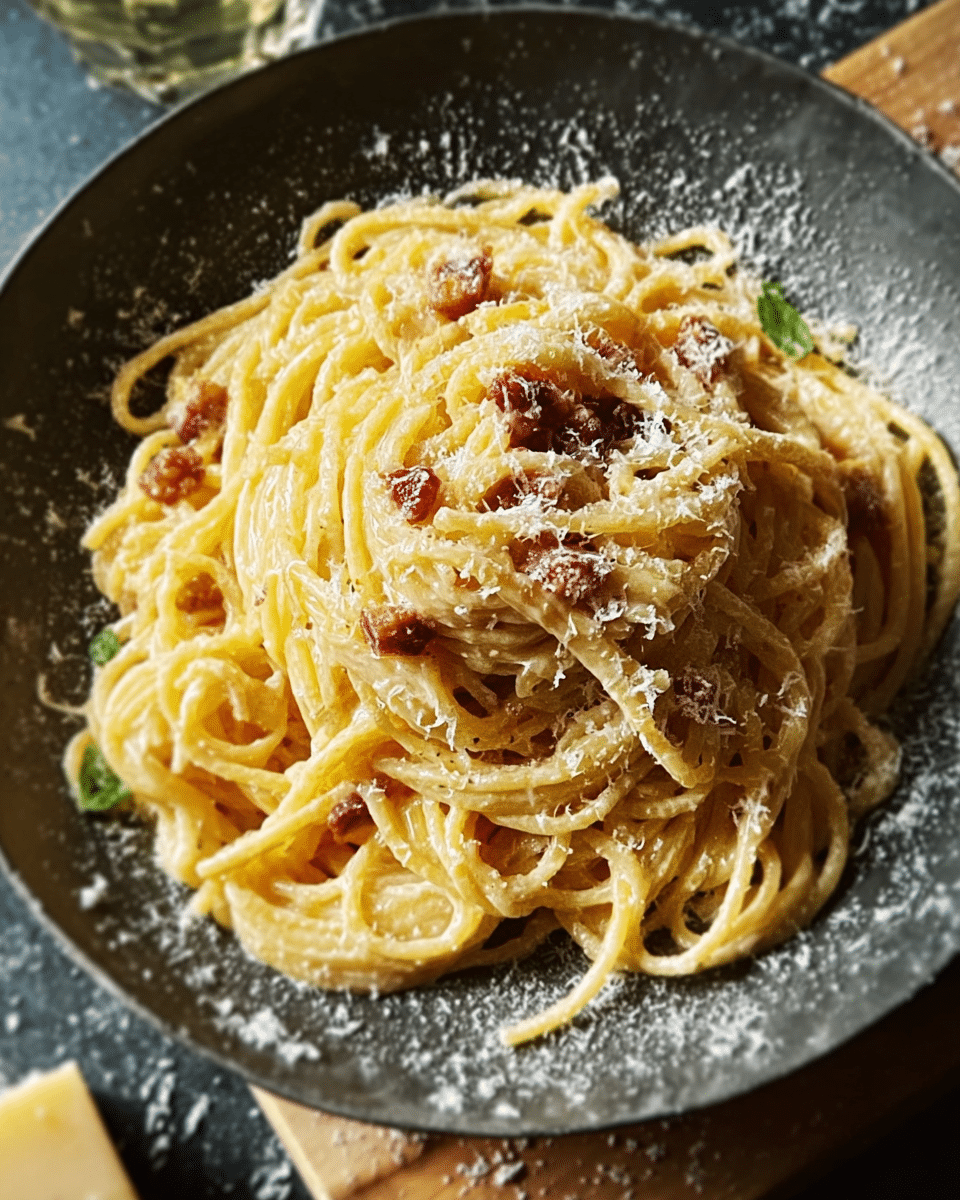The elegance of Stanley Tucci’s Pasta Carbonara lies in its restraint just pasta, guanciale, eggs, Pecorino Romano, and pepper, united through skill and timing. Each strand is coated in a velvety sauce created without cream, allowing the savory cured pork and tangy cheese to shine.
This dish captures the heart of Roman cooking: simple ingredients elevated by technique. Perfect for a quick weeknight indulgence or a dinner party showpiece, it’s a reminder that true culinary magic often comes from doing less, but doing it perfectly.
Full Recipe:
Ingredients:
-
12 oz spaghetti
-
4 oz guanciale (or pancetta if unavailable), diced
-
2 large eggs
-
1 large egg yolk
-
1 cup grated Pecorino Romano cheese
-
Freshly ground black pepper, to taste
-
Salt, for pasta water
Directions:
-
Bring a large pot of salted water to a boil. Cook the spaghetti until al dente according to package instructions.
-
While the pasta cooks, heat a skillet over medium heat and add diced guanciale. Cook until golden and crispy, about 5–7 minutes. Remove from heat.
-
In a bowl, whisk together eggs, egg yolk, Pecorino Romano cheese, and a generous amount of black pepper until smooth.
-
Once pasta is cooked, reserve 1 cup of pasta water, then drain the rest.
-
Add the hot pasta directly into the skillet with guanciale (off heat), stirring to combine. Allow to cool slightly for 30 seconds.
-
Pour the egg-cheese mixture into the pasta, stirring vigorously to create a creamy sauce without scrambling the eggs.
-
Adjust consistency with reserved pasta water if needed.
-
Serve immediately with extra Pecorino Romano and black pepper.
Prep Time: 10 minutes | Cooking Time: 15 minutes | Total Time: 25 minutes
Kcal: 520 kcal | Servings: 4 servings
Stanley Tucci’s Pasta Carbonara – A Love Letter to Roman Cuisine
Pasta Carbonara has earned its place among the most beloved pasta dishes in the world, and Stanley Tucci’s version captures its soul in the most authentic way possible. This is not just a recipe it’s a celebration of Italy’s culinary philosophy: simplicity, quality, and respect for tradition. Through his travels in Searching for Italy, Tucci introduced countless viewers to the heart of Roman cooking, and his take on Carbonara embodies why the dish has captured global hearts and palates.
The Essence of Carbonara
At its core, Pasta alla Carbonara is deceptively simple: pasta, cured pork, cheese, eggs, and black pepper. But this apparent simplicity hides a world of nuance. The magic lies not in the number of ingredients, but in how they are combined. In Tucci’s Carbonara, there are no shortcuts and certainly no cream a common misstep outside of Italy. Instead, the rich, silky sauce comes from the careful emulsification of eggs and Pecorino Romano with the rendered fat of guanciale and just the right splash of pasta water.
The result is a glossy, savory coating that clings to every strand of pasta, balancing the salty bite of cheese with the luxurious depth of cured pork. Each bite tells the story of Roman culinary heritage, where humble ingredients have been elevated into icons through technique and tradition.
A Dish Steeped in History and Myth
The origins of Carbonara are still debated among historians and food lovers alike. Some claim it was born during World War II when American soldiers in Italy combined bacon and powdered eggs with pasta. Others insist that it predates the war entirely, evolving from a rustic shepherd’s dish in the Apennine mountains.
The name Carbonara itself is thought to derive from carbonari, or charcoal workers, suggesting the dish once served as a hearty meal for laborers who spent long days outdoors. Some even believe that the generous sprinkling of black pepper represents flecks of coal, a nod to its working-class heritage.
What’s certain is that Carbonara has become one of Rome’s culinary pillars, alongside Cacio e Pepe, Amatriciana, and Gricia. Each of these dishes shares a similar flavor DNA pasta, cheese, pork, and pepper yet each stands on its own, defined by subtle variations in technique and proportion.
Why Tucci’s Version Stands Out
Stanley Tucci’s Carbonara is noteworthy for its fidelity to Roman tradition. In an age when recipes are often adapted beyond recognition, his approach is refreshingly purist. He uses guanciale, not bacon or pancetta, because of its unmatchable depth and melt-in-your-mouth texture. He chooses Pecorino Romano over Parmesan for its sharper, saltier profile that cuts beautifully through the richness of the sauce. And most importantly, he stays true to the no-cream rule, relying instead on the emulsification process to create that luscious texture.
This level of discipline reflects Tucci’s broader philosophy about Italian food it’s not about reinventing the wheel, but about respecting the wheel’s perfect shape. His Carbonara isn’t trying to surprise you with unusual twists; it’s aiming to honor a centuries-old method and deliver a dish that feels timeless.
The Technique is Everything
Cooking Carbonara the authentic way requires attentiveness and precision. The eggs should never scramble, which means timing is critical. The residual heat from the pasta and guanciale is used to gently set the eggs and melt the cheese into a creamy, clingy sauce. Stirring is vigorous but controlled, and pasta water is added in small increments to achieve the ideal consistency.
This step is where many home cooks stumble, but it’s also the moment where the dish transforms from a simple pasta into a Roman masterpiece. Tucci’s emphasis on this technique underscores an important truth: Italian cuisine rewards patience and care far more than excessive complexity.
Carbonara as a Cultural Symbol
In Rome, Carbonara isn’t just food it’s an expression of identity. It represents a proud lineage of home cooks, trattoria chefs, and food traditions passed down through generations. Locals debate the best ratio of cheese to eggs, the perfect thickness of guanciale slices, and even the exact coarseness of black pepper. Deviations such as adding garlic, onions, or cream are often considered sacrilegious among purists.
By sharing this recipe in its pure form, Tucci invites us not only to enjoy the dish but also to connect with its cultural roots. To cook Carbonara is, in a way, to participate in an unbroken culinary conversation stretching back decades, if not centuries.
Pairing and Serving
The richness of Carbonara calls for accompaniments that refresh the palate. In Rome, it’s common to pair it with a crisp green salad dressed with lemon vinaigrette or a side of seasonal vegetables prepared simply. As for wine, a dry white such as Frascati complements the dish beautifully, though a light red like Chianti can hold its own if you prefer a bolder pairing.
For the full Roman trattoria experience, you might follow your Carbonara with a small glass of limoncello or a strong espresso. It’s a reminder that meals in Italy are not rushed they are savored, enjoyed, and shared.
Why This Dish Resonates Globally
One reason Tucci’s Pasta Carbonara resonates so widely is its accessibility. The ingredients are pantry staples in most kitchens, yet the dish feels luxurious and indulgent. It can be prepared in under 30 minutes, making it as suitable for a weeknight dinner as it is for a celebratory meal.
There’s also the emotional connection it fosters. For many, Carbonara is comfort food warm, rich, and deeply satisfying. For others, it’s a culinary challenge that offers the joy of mastering a classic technique. And for those who have traveled to Rome, it can evoke vivid memories of cobblestone streets, bustling trattorias, and the intoxicating aroma of fresh pasta being tossed in a pan.
The Tucci Effect
Stanley Tucci’s culinary influence has grown tremendously in recent years, thanks in large part to his ability to tell the stories behind the food. When he shares a recipe like Carbonara, he’s not just demonstrating how to cook it—he’s giving context, history, and personal connection. This makes his version of the dish more than just a set of instructions; it becomes an invitation to experience a piece of Italian life.
By spotlighting Carbonara in his travels, Tucci has helped rekindle appreciation for authenticity in cooking. In a world where food trends come and go, his advocacy for traditional methods reminds us that some recipes are already perfect the way they are.
Conclusion:
Stanley Tucci’s Pasta Carbonara is far more than a comforting plate of pasta it’s a masterclass in how simplicity, when paired with technique and respect for tradition, can yield extraordinary results. Each element of the dish serves a purpose, from the salty bite of Pecorino Romano to the luxurious depth of guanciale.
Whether you’re an experienced cook or someone attempting Carbonara for the first time, Tucci’s approach offers both inspiration and guidance. It encourages you to slow down, focus on quality, and embrace the beauty of doing just enough but doing it perfectly. In the end, the real magic of this dish is not just in how it tastes, but in the way it connects you to a rich culinary heritage that continues to captivate the world.






